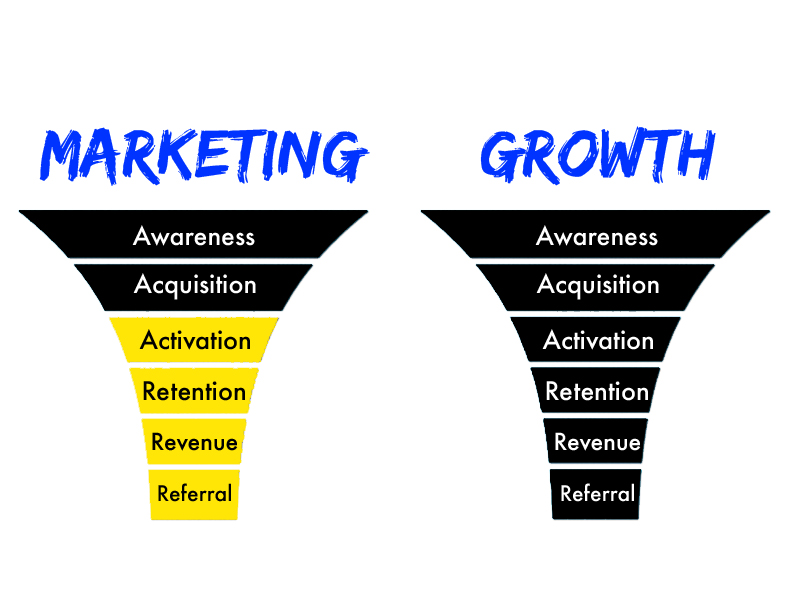\ Ultimate Guide to Growth Marketing
Growth marketing can help you to build and grow your business in ways you never imagined possible through marketing. Many think marketing is advertising to the customer, but there are many layers to it. We dive deep into growth marketing.
The meaning of growth will differ from company to company, but ultimately growth could mean any of the following:
- Increasing business revenue and maximising profit
- Finding a new audience
- Increasing customer base
- Forming new partnerships with more clients
- Even, expanding your internal teams with new marketing members
Measuring growth can be done with a number of tools, but it is important for growth, the measurement to be consistent. Without steady growth, your business will eventually become stagnant and see massive drop offs.
Growth needs to be consistent and effective to ensure steady success. It is also important for growth to be sustainable over any longer periods of time. Otherwise, the results will not lead to any long-term benefits.

You’ve got growth goals? We’ll build the roadmap.
Businesses need a data-driven vision. More importantly, they need a clear, action-packed game plan. We partner with you to strategize, prioritize, link up cross-channel insights, and, ultimately, grow.
How Marketing Contributes to Growth
Marketing is a requirement if you want success and growth in any business. Marketing ensures the steady flow of customers. It also raises the awareness and brings the attention of more people to the services your business has to offer. However, it’s important to remember that growth across your marketing will take time. There’s no silver bullet to it and it doesn’t happen overnight.
Growth marketing is not a buzzword or a trend. It’s the key to unlocking the transformation of your business. This is also why it’s crucial to keep your marketing teams or yourself up-to-date with the latest marketing trends.
Do you ever wonder how to use growth marketing strategies to redefine your business success? We’ll also discuss the basics of growth marketing. But first, let’s take a quick look at how the growth marketing world started and evolved.
What is Growth Marketing?
Growth marketing is about focusing on all stages of the sales funnel. It’s about maximising the lifetime value of a customer. Utilising growth marketing across your marketing efforts ensures that a customer continues to use and champion the services of a company even in the future. Growth marketing concerns itself with achieving this using minimal cost and time input. Using the right tools for time management is of the essence when it comes to growth marketing – by tracking time and results, you can easily check your growth marketing progress.
This means experimenting undertaking different tactics to find ways of acquiring new customers at the top of the funnel. It also means developing tactics and strategies that’ll increase customer retention down the funnel.
They can use the results to find out what works and what doesn’t. They can then refine the data, improving on what works, and letting go of what doesn’t work. This is what helps a business to build a framework for success.
Difference between Growth Marketing and Traditional Marketing
Traditional marketing – including traditional digital marketing – is about lead generation. It involves focusing the entire marketing efforts of a company on the top of the sales funnel. More than 85% of B2B marketers consider lead generation as the most important goal in their content marketing strategies.
When you point all your efforts into this style of marketing for leads only, you will miss opportunities. Opportunities get overlooked in terms of nurturing and building meaningful relationships with customers. Traditional focuses on acquisition only. It then neglects leveraging the entire sales funnel to bring about growth.
Growth-marketing focuses on strategies and individual tactics to help acquire new customers and retain them. The purpose is to build customer engagement at all levels of the sales funnel. On the other hand, traditional marketing focuses almost entirely on acquiring new customers.

You’ve got growth goals? We’ll build the roadmap.
Businesses need a data-driven vision. More importantly, they need a clear, action-packed game plan. We partner with you to strategize, prioritize, link up cross-channel insights, and, ultimately, grow.
Why Growth Marketing is Important
Growth marketing focuses on the total life-time value of a customer. It involves using strategies and tactics to improve the acquisition of new customers which also proves useful in improving the number of purchases that customers make in the future.
Existing customers are 50% more likely to spend money on new products from your company when you launch them. This is why customer acquisition and retention are important as it saves money on marketing to a new segment.
This difference is attributable to trust. A customer who trusts you is easy to upsell. They can even convince new customers to try out your product. This gives you the chance to repeat the “acquisition, retention, and engagement” cycle.
5 Steps to Carrying out Growth Marketing
Growth marketing involves the following 3 major strategies and you will find other parts to this when your business is in a different industry or size:
- Do
- Measure
- Refine
A growth marketer continuously tries out both conventional (for those low hanging fruit success elements) to unconventional growth strategies. We measure the effectiveness of each strategy. The results are then refined to achieve better results in the future or through a different marketing channel. You have to find ways to optimise online ads, landing pages of websites, email copy and product page’s.
Step 1: Develop your product
Many people go about this step in the wrong way. You need to involve your customers in the product development process. Do not focus only on creating the right product in your head. After creating the first version of your product, ask your customers for feedback. What will they like you to improve on?
Involving your customers in the process from the very start is a great way to earn their trust and support. Ask for feedback from your friends and family. The moment you get a “go-ahead,” don’t waste further time trying to create the perfect product. Launch it as it is and continue with the feedback process.
Step 2: Build out your Growth Framework
In growth marketing, we as marketers will make use of well known software to analyse various distribution channels.
In essence, those channels with the best performance are then given full focus. To achieve growth, experimentation and testing should be done in high-velocity and high-tempo. This means you should deploy and experiment your best ideas as quickly as possible.
Once you have started experimenting with different tactics, the next step is to collect the data from these experiments immediately. Finally, you use the collected data to understand what works best. This is useful in formulating a working process that you can use repeatedly.
The processes involved in carrying out high velocity experiments include:
- Gathering ideas with your team members
- Choose the best ideas and prioritise them
- Execute each of the ideas
- Measure and record the outcome
- Continue with the good and don’t go with the bad
Step 3: Optimise the Top of Your Funnel
It is always better to start from the top where your customer first hears of you. To achieve this, you need to carry out experiments to find the best way to optimise your landing or content pages.
The homepage is among the most important aspects of your website as it acts as your store front. It can determine your conversion rate. When customers visit your website, they expect a mobile friendly, user friendly, fast to load, and easy to navigate design. These things will drive them to take action by clicking on your call to action or investigating deeper your products.
Step 4: Optimise the deeper stages of your Funnel
Growth marketers, unlike traditional marketers, focus on the entire funnel. They use this technique to achieve an increase in customer retention and engagement.
In this step, you have to optimise other elements of your website. You also have to develop your content strategy, this is a great way to increase virality. By achieving this, you can quickly cover up for customer acquisition costs.
Step 5: Take advantage of social media and go viral!
Use social media to post optimised and well thought out content around your products. It is a great way to boost growth and also a great way to acquire new customers, retain them, and engage with both new and existing customers.
You’ve got growth goals? We’ll build the roadmap.
Businesses need a data-driven vision. More importantly, they need a clear, action-packed game plan. We partner with you to strategize, prioritize, link up cross-channel insights, and, ultimately, grow.


